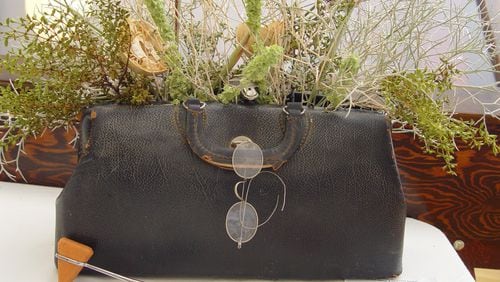I discovered the true meaning of sustainability at this year’s fall Twentynine Palms Weed Show. It’s a little known 70-year-old tradition held in a remote town deep in California’s Mojave Desert. This is the little known Oasis of Mara, now the hamlet of Twentynine Palms, an hour northeast of Palm Springs. It’s a short jump to the Marine Base, which wasn’t there when the show started. It was founded much earlier, by convalescents from WWI mustard gas who took the long trip on dirt roads to the isolated area with air ideal for healing ravaged lungs. Pasadena physician Dr. Luckie treated fathers, sons and brothers for mustard gas after the war and insisted they all move to the therapeutic climate.
In lieu of the flowers shows they were used to, the former society women were inspired by an artist to create beautiful arrangements of dried plants from the desert. This helped the Woman’s Club of 29 to create a new approach to blending elements of the desert with dried native plants. This is how the tradition was born, the first show in 1941, which still exists to inspire us today by nothing short of a miracle.
In a world of limited water, the show seems the most appropriate way of creating love of plants and flowers from all habitats. It’s a show that’s judged with a different theme each year. Locals create unique arrangements of found items, recycled stuff and most importantly, dried remnants of plants from the desert. They are arranged to tell a story unique to each viewer who recognizes the components used in a brand-new way.
What makes the show so different and such a great idea is people actually go looking for junk and dead plants to make art. You don’t need any prior floral experience, and nothing is newly bought. This helps novices on a budget to study a dried pod or stem or gnarled roots they’d otherwise step on and not give a second thought. But when you’ve seen Weed Show arrangements, you realize how much time, vision and beauty each creation required. Anyone can enter a weed show, but at 29, there are rules such as “nothing painted.” This keeps the look and feel of the arrangements just as they were during those early years when the ladies began the show.
In the desert, everything is baked to death over the summer. The roadsides and trails and vacant lots are full of dead, dry plants, just as they are everywhere else in the fall. It’s a natural for gathering and combining this time of year. These are the stuff of creativity blended with rusty metal, purple antique glass shards and truly unusual found objects.
The weed show concept is one that deserves to spread all over the dry West and further. A weed is simply a plant out of place. Weed Show weeds are any dry plant or plant part both native and exotic that is interesting and contributes to an arrangement theme. When thickets of weeds are studied in this context, you’d be surprised at what you find and learn in the process. Peruse the show and its photo history of past entries for great inspiration online at 29palmshistorical.com.
This provides us with a plant-based social expression without growing anything. It demands no more water than what falls from the sky. Here’s an ideal decor idea that really works with white walls which bring out unique earth tones, textures and forms of dry plants. Hikers and walkers will find new interest in keeping an eye out for that special piece of twisted wood or vine.
America, let’s take our inspiration from the original Twentynine Palms Weed Show to bring dried plant arrangements back into our artistic milieu nationwide. The look and feel can be unique to each community and its native plants, which helps to establish a new design vernacular. Above all, it helps get us out of the house in the great fall weather to wander our own open spaces in search of just the right weeds to arrange.
———
Maureen Gilmer is an author, horticulturist and landscape designer. Learn more at www.MoPlants.com






